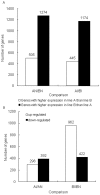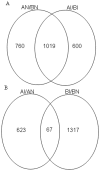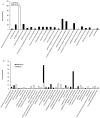Gene expression profiling of the local cecal response of genetic chicken lines that differ in their susceptibility to Campylobacter jejuni colonization
- PMID: 20676366
- PMCID: PMC2911375
- DOI: 10.1371/journal.pone.0011827
Gene expression profiling of the local cecal response of genetic chicken lines that differ in their susceptibility to Campylobacter jejuni colonization
Abstract
Campylobacter jejuni (C. jejuni) is one of the most common causes of human bacterial enteritis worldwide primarily due to contaminated poultry products. Previously, we found a significant difference in C. jejuni colonization in the ceca between two genetically distinct broiler lines (Line A (resistant) has less colony than line B (susceptible) on day 7 post inoculation). We hypothesize that different mechanisms between these two genetic lines may affect their ability to resist C. jejuni colonization in chickens. The molecular mechanisms of the local host response to C. jejuni colonization in chickens have not been well understood. In the present study, to profile the cecal gene expression in the response to C. jejuni colonization and to compare differences between two lines at the molecular level, RNA of ceca from two genetic lines of chickens (A and B) were applied to a chicken whole genome microarray for a pair-comparison between inoculated (I) and non-inoculated (N) chickens within each line and between lines. Our results demonstrated that metabolism process and insulin receptor signaling pathways are key contributors to the different response to C. jejuni colonization between lines A and B. With C. jejuni inoculation, lymphocyte activation and lymphoid organ development functions are important for line A host defenses, while cell differentiation, communication and signaling pathways are important for line B. Interestingly, circadian rhythm appears play a critical role in host response of the more resistant A line to C. jejuni colonization. A dramatic differential host response was observed between these two lines of chickens. The more susceptible line B chickens responded to C. jejuni inoculation with a dramatic up-regulation in lipid, glucose, and amino acid metabolism, which is undoubtedly for use in the response to the colonization with little or no change in immune host defenses. However, in more resistant line A birds the host defense responses were characterized by an up-regulation lymphocyte activation, probably by regulatory T cells and an increased expression of the NLR recognition receptor NALP1. To our knowledge, this is the first time each of these responses has been observed in the avian response to an intestinal bacterial pathogen.
Conflict of interest statement
Figures




Similar articles
-
Caecal transcriptome analysis of colonized and non-colonized chickens within two genetic lines that differ in caecal colonization by Campylobacter jejuni.Anim Genet. 2011 Oct;42(5):491-500. doi: 10.1111/j.1365-2052.2010.02168.x. Epub 2011 Feb 1. Anim Genet. 2011. PMID: 21906100
-
Role of Cecal Microbiota in the Differential Resistance of Inbred Chicken Lines to Colonization by Campylobacter jejuni.Appl Environ Microbiol. 2020 Mar 18;86(7):e02607-19. doi: 10.1128/AEM.02607-19. Print 2020 Mar 18. Appl Environ Microbiol. 2020. PMID: 31980428 Free PMC article.
-
Intestinal colonization and acute immune response in commercial turkeys following inoculation with Campylobacter jejuni constructs encoding antibiotic-resistance markers.Vet Immunol Immunopathol. 2019 Apr;210:6-14. doi: 10.1016/j.vetimm.2019.02.003. Epub 2019 Mar 1. Vet Immunol Immunopathol. 2019. PMID: 30947981
-
A tolerogenic mucosal immune response leads to persistent Campylobacter jejuni colonization in the chicken gut.Crit Rev Microbiol. 2012 Feb;38(1):17-29. doi: 10.3109/1040841X.2011.615298. Epub 2011 Oct 13. Crit Rev Microbiol. 2012. PMID: 21995731 Review.
-
Colonization properties of Campylobacter jejuni in chickens.Eur J Microbiol Immunol (Bp). 2012 Mar;2(1):61-5. doi: 10.1556/EuJMI.2.2012.1.9. Epub 2012 Mar 17. Eur J Microbiol Immunol (Bp). 2012. PMID: 24611122 Free PMC article. Review.
Cited by
-
Evaluation of the immunogenicity of Campylobacter jejuni CjaA protein delivered by Salmonella enterica sv. Typhimurium strain with regulated delayed attenuation in chickens.World J Microbiol Biotechnol. 2014 Jan;30(1):281-92. doi: 10.1007/s11274-013-1447-5. Epub 2013 Aug 4. World J Microbiol Biotechnol. 2014. PMID: 23913025 Free PMC article.
-
Differences in host breed and diet influence colonization by Campylobacter jejuni and induction of local immune responses in chicken.Gut Pathog. 2016 Nov 10;8:56. doi: 10.1186/s13099-016-0133-1. eCollection 2016. Gut Pathog. 2016. PMID: 27843492 Free PMC article.
-
The genomic architecture of resistance to Campylobacter jejuni intestinal colonisation in chickens.BMC Genomics. 2016 Apr 18;17:293. doi: 10.1186/s12864-016-2612-7. BMC Genomics. 2016. PMID: 27090510 Free PMC article.
-
Genome-wide association analysis of avian resistance to Campylobacter jejuni colonization identifies risk locus spanning the CDH13 gene.G3 (Bethesda). 2013 May 20;3(5):881-90. doi: 10.1534/g3.113.006031. G3 (Bethesda). 2013. PMID: 23550144 Free PMC article.
-
Campylobacter jejuni is not merely a commensal in commercial broiler chickens and affects bird welfare.mBio. 2014 Jul 1;5(4):e01364-14. doi: 10.1128/mBio.01364-14. mBio. 2014. PMID: 24987092 Free PMC article.
References
-
- Buzby JC, Allos BM, Roberts T. The economic burden of Campylobacter-associated Guillain-Barre syndrome. J Infect Dis. 1997;176(Suppl 2):S192–197. - PubMed
-
- Buzby JC, Roberts T, Allos BM. Estimated Annual Costs of Campylobacter-Associated Guillain-Barre Syndrome. 1997. 70 70. - PubMed
-
- Boyd Y, Herbert EG, Marston KL, Jones MA, Barrow PA. Host genes affect intestinal colonisation of newly hatched chickens by Campylobacter jejuni. Immunogenetics. 2005;57:248–253. - PubMed
Publication types
MeSH terms
LinkOut - more resources
Full Text Sources
Molecular Biology Databases

